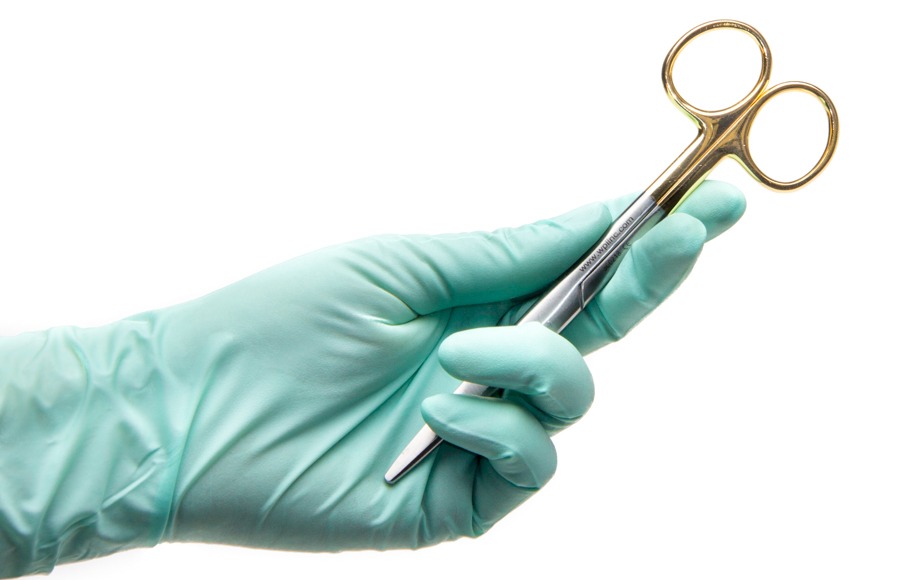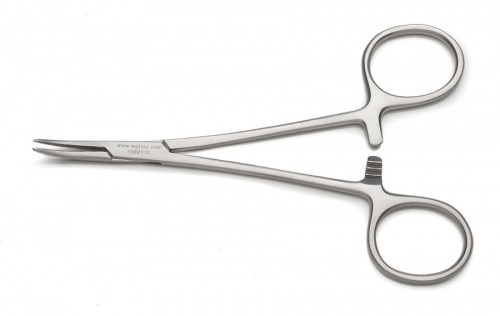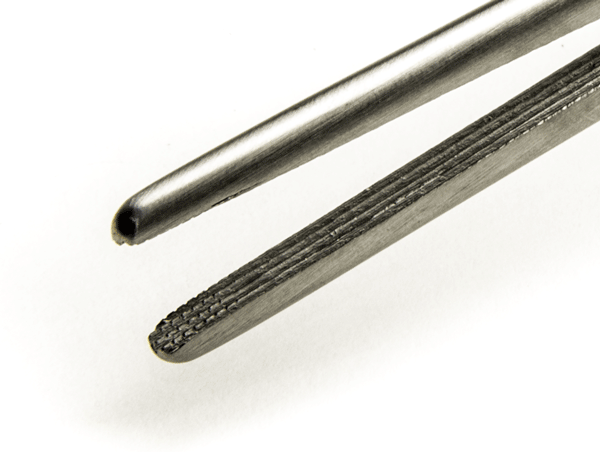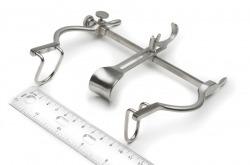 When you are selecting surgical instruments for a procedure, here are a few key points to consider
When you are selecting surgical instruments for a procedure, here are a few key points to consider
- What procedure are you performing? Published research papers usually indicate which instruments other researchers have used for similar procedures. The correct surgical instrument for a particular procedure makes a difference on the outcome of that technique.
- What is the size of your subject? An instrument that is perfect for a 200–300 g rat (about 22–25 cm long) may not be the best choice for a neo-natal mouse of about 15 g (about 1–2.5 cm long).
- How often will the instrument be used? If you perform more than 100 cuts per day, a pair of titanium scissors or a pair of scissors with tungsten carbide inserts would be worth considering. They stay sharp longer.
In this article we will consider some of these factors and offer a few tips for selecting an appropriate pair of scissors, tweezers and forceps.
Types of Surgical Instruments
Most of our surgical instruments can be used for general surgery in a research laboratory setting. Instruments may be roughly categorized by function:
- Cutting instruments include scissors, surgical blades, knives and scalpels.
- Grasping or holding instruments include hemostatic forceps and tissue forceps.
- Retractors, which hold incisions open or hold an organ (or tissue) out of the way, include Gelpi, Weitlaner and US Army style instruments.
In addition to surgical instruments, we have many accessories available, which include all the extras needed for surgery. These include clamps, from large towel clamps to delicate vessel clips and bulldog clamps, drills, sutures, binocular loupes, biopsy punches and more.
Cutting Instruments

Scissors are cutting instrument with two blades joined together at a pivot point so that the sharp edges glide against each other to shear material that is between the blades. Here are some tips to keep in mind when selecting an appropriate pair of surgical scissors:
- Fine tip scissors (like Vannas, Castroviejos and McPhersons) are ideal for use in very restricted spaces. They are perfect for right or left hand use, and are designed for ophthalmological procedures, which require a delicate incision of tissue. You can make quick, accurate cuts with minimal tissue damage using these sharp blades.
- Curve tipped scissors are a good choice when you want to avoid cutting underlying tissues.
- Scissors designed with a heavier construction (like Metzenbaum, Mayo and SuperCut scissors) are useful for cutting fur, thicker tissue or vessels.

- The length of the scissor tips should match the depth of the incision you need to make.
- Scissors made with a heavier construction can be used to cut fur, thicker tissue, bones and muscle.
Iris SuperCut Scissors Our black handled surgical scissors designate our SuperCut scissors. These scissors have one on razor sharp blade and one micro-serrate blade. The sharp edge gives a clean cut with minimal tissue damage, and the serrated edge actually holds the tissue to prevent it from slipping while you are making an incision. - Scissors with tungsten carbide inserts have golden handles. Tungsten carbide instruments are more durable, hold an edge longer and last longer than stainless steel instrument.
- Scissors with on black handle and one gold handle are both serrated and have tungsten carbide blade inserts, giving you the very best of both worlds.
- Spring scissors are perfect for left or right hand use. They are designed for neurosurgical, vascular, microsurgical and ophthalmological uses.
Sapphire Blade Sapphire blades may be used in microsurgery, dissection and related applications. They are not as hard as a diamond, but still hundreds of times harder then a razor blade. Sapphire blades can cuts with minimum pressure, without tearing or damaging the specimen. The blades are corrosion free and resistant to saline solution. They offer a super sharp cutting edge, and they work with stainless steel or titanium handles. These blades may be autoclaved up to 200ºC.
Some common types of scissors include:
- Vannas scissors are delicate spring scissors, which are perfect for right or left hand use. They are used frequently in ophthalmic and neurosurgical applications. The fine scissor blades are sharp. Vannas scissors work well under a dissection microscope.
- Castroviejo scissors were designed for ophthalmologic procedures, which require a delicate incision of tissue. You can make quick, accurate cuts with minimal tissue damage using these sharp blades.
- McPherson-Vannas scissors were originally designed for ophthalmologic work requiring fine delicate blades for such intricate work.
Grasping Instruments
Surgical forceps may be broadly divided into two categories, ring forceps (also called hemostats, hemostatic forceps and locking forceps) and thumb forceps (frequently called tweezers or pinning forceps). Here are some tips to keep in mind when selecting an appropriate pair of forceps:
- Reverse forceps are self-closing. You squeeze them to open them. They provide uniform tension.
- Ceramic tipped forceps are non-porous, corrosion and heat resistant and insulated.
- Straight tips on forceps are used for general precision work, and slightly curved or fully curved tips provide more visibility

Ring forceps, also called hemostats or locking forceps, are an instrument for grasping, holding firmly or exerting traction upon objects especially for delicate operations. They are hinged and look like ring scissors. Frequently, hemostatic forceps have a locking mechanism called a ratchet, which is used for clamping. The jaws of the locking forceps gradually come together as each increment of the ratchet is employed.
Locking hemostatic forceps may be called clamps and are used to securely hold tissue. When they are used to control blood flow, they are called hemostats. Hemostats are typically used to compress blood vessels or other tubular structures to obstruct the flow of blood or fluids.
Common types of ring forceps include:
- Kelly hemostats can be used to clamp larger vessels or grasp tissue. Kelly hemostats and Rochester forceps look similar. However, Kelly hemostats have shorter serrations. Rochester hemostats can reach a little deeper.
- Hartman Mosquito forceps have fine, short tips and a serrated jaw. Hartman Mosquito hemostats are used as hemostats for clamping small blood vessels and in fine tissue dissection when the incision is shallow. Use them to clamp small blood vessels or hold fine sutures. For a lighter and longer hemostat, try the Halstead Mosquito Forceps.
- Allis tissue forceps have sharp teeth for gripping heavy tissue. Because they can cause damage, they typically hold tissue that is to be removed.
- Crile hemostats are similar to Halsted Mosquito forceps, but they are a little larger.
- Rochester-Oschner forceps are heavy hemostats designed for clamping large vessels or grasping dense tissue. They are serrated for grasping and often have teeth at the tip, too.
 Stars and stripes tips of
Stars and stripes tips of
Rochester-Carmalt forceps Rochester-Carmalt forceps, nicknamed the “stars and stripes hemostat,” are characterized by the longitudinal serrations that run the length of the blade with cross-hatching at the tip. These large, crushing hemostatic forceps are a choice instrument for clamping blood vessels and large tissues or ligating pedicles. - Rochester-Pean hemostatic forceps are designed with full horizontal serrations for clamping larger tissue and vessels.
Thumb forceps are spring forceps used by compression between your thumb and forefinger and are used for grasping, holding or manipulating body tissue. They have no ratchet in the handle. Two broad categories of thumb forceps are dressing forceps and tissue forceps. Dressing forceps are used when dressing wounds and removing dressings. Very fine dressing forceps are also used in eye surgery. Tissue forceps generally have teeth, which offer a better grip on tissues while minimizing tissue damage.
Common types of thumb forceps include:
- Adson tissue forceps are designed for grasping delicate tissues, and they have 1×2 teeth.
- Bonn tissue forceps are designed for delicate work, and they include a tying platform to assist when you are tying sutures.
- Foerster tissue forceps work well when handling delicate tissue. These serrated forceps have the unique octagonal keyhole in the handle, giving your tactical feedback and control. The keyhole also gives you a better grip, especially when you are wearing gloves. When you need a firm grip and minimal tissue trauma, the Foerster forceps are an excellent choice.
- Iris forceps are designed for use in ophthalmologic work. The Iris dressing forceps are serrated and the Iris tissue forceps have 1×2 teeth.
- Graefe forceps have a horizontal row of 6 (or 8) small teeth for grasping tissue. They are most commonly use in ophthalmologic applications.
Retractors
Retractors are used to hold an incision or a wound open, to hold an organ or tissue out of the way to expose what’s underneath.
- An assistant, a robot or the surgeon must hold hand retractors during a procedure.
- Self-retaining retractors have a mechanical device for holding tissue during surgery, allowing hands-free operations. Self-retaining retractors have a screw, ratchet or some type of clamp to hold the tissue by itself. These allow the surgeon to operate with two free hands.
- Wire retractors are the simplest style of retractor. Usually the wire has some spring so that the surgeon can pinch it together, position it and release it. These also free up the surgeon’s hands.
Choosing Your Instruments
The instruments you select for your procedure are affected by many factors. Basic knowledge of common surgical instruments can help you select appropriate tools for your application.


